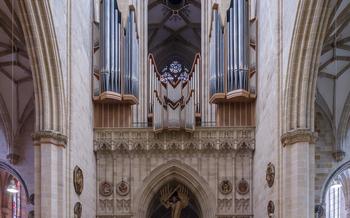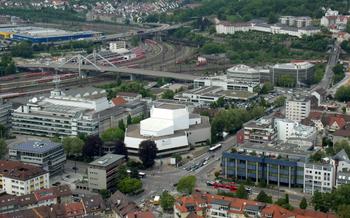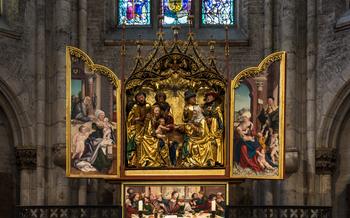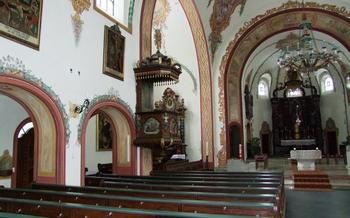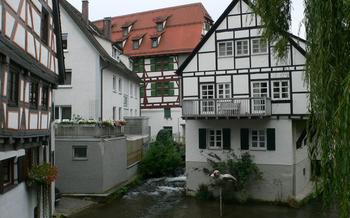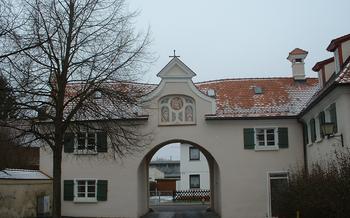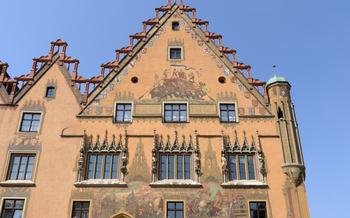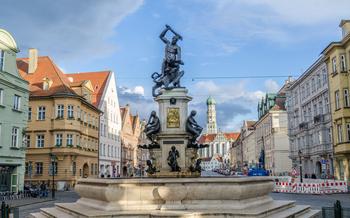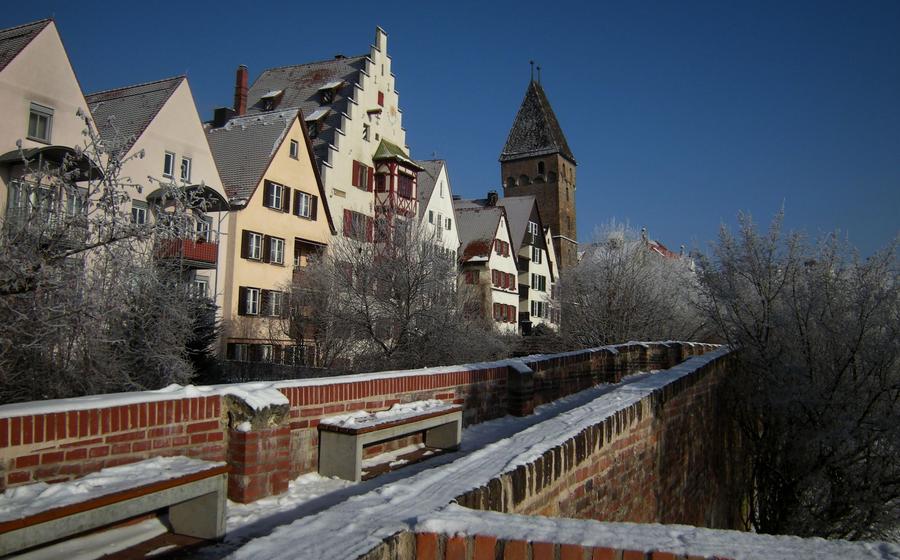
Ulm City Wall (Stadtmauer)
- Ulm City Wall (Stadtmauer): A Legacy of Resilience
- Walking the Wall: A Journey Through History
- The Metzgerturm: A Tower with a View
- The Wiblingen Abbey: Baroque Masterpiece
- Ulm Cathedral: A Gothic Marvel
- The Fishermen's Quarter: A Picturesque District
- The Town Hall: A Symbol of Civic Authority
- The Einstein Fountain: A Tribute to Genius
- Location and accessibility
- Artistic interpretation
- Historical significance
- Nearby attractions
- The Chinese Garden: A Peaceful Oasis
- Traditional Design and Serene Atmosphere
- Cultural Events and Nearby Attractions
- The Kunsthalle Weishaupt: A Modern Art Haven
- The Friedrichsau Park: A Green Escape
- Insider Tip: The "Ulmer Spatz": A Local Delicacy
Ulm City Wall (Stadtmauer): A Legacy of Resilience
Ulm's City Wall, known as the Stadtmauer, stands as a testament to the city's rich history and resilience. Constructed in the 14th century, this impressive fortification once served as a protective barrier against invading forces. Its strategic location on the banks of the Danube River made Ulm a vital trading hub, and the wall played a crucial role in safeguarding the city's prosperity and independence.
Historical Significance:
The Ulm City Wall is a tangible reminder of Ulm's tumultuous past. It withstood numerous sieges and attacks throughout the centuries, including during the Thirty Years' War when the city was occupied by Swedish forces. The wall's resilience and effectiveness as a defensive structure contributed significantly to Ulm's ability to maintain its autonomy and resist foreign influence.
Architectural Features:
The Stadtmauer is a remarkable feat of medieval engineering, showcasing the architectural prowess of its builders. Constructed primarily of massive stone blocks, the wall features a double ring of fortifications, with an outer wall and an inner wall separated by a moat. The outer wall is adorned with imposing towers and bastions, while the inner wall is characterized by a series of smaller towers and gates.
Defensive Mechanisms:
The Ulm City Wall incorporated several ingenious defensive mechanisms to protect the city from attack. Arrow slits and machicolations allowed defenders to rain down projectiles on approaching enemies, while a series of portcullises and drawbridges provided additional layers of security. The moat, which was once filled with water, further hindered the progress of attackers and made it difficult for them to breach the wall.
Symbol of Civic Pride:
The Ulm City Wall is a source of immense pride for the people of Ulm. It represents the city's determination to preserve its independence and its ability to overcome adversity. The wall's enduring presence serves as a reminder of Ulm's rich heritage and its resilience in the face of challenges.
Walking the Wall: A Journey Through History
Strolling along the Ulm City Wall is like embarking on a journey through time, where every step unveils a chapter of the city's rich history. Guided tours, led by knowledgeable local guides, offer an immersive experience, delving into the fascinating stories and legends that shaped Ulm's past. Alternatively, self-guided exploration allows visitors to wander at their own pace, soaking in the atmosphere and capturing the essence of this architectural marvel.
The wall's panoramic city views are simply breathtaking, offering unparalleled vistas of Ulm's iconic landmarks and the surrounding countryside. Gaze upon the soaring spire of Ulm Cathedral, the tranquil waters of the Blautopf, and the lush greenery of the Friedrichsau Park, all from the vantage point of this historic fortification. Along the way, discover the wall's impressive fortifications and towers, each with its own unique story to tell.
The Metzgerturm: A Tower with a View
Perched atop the Ulm City Wall, the Metzgerturm, or Butcher's Tower, stands as a testament to the city's rich history and architectural prowess. Easily accessible via a staircase, the tower offers visitors a unique perspective and a journey through time.
Originally constructed in the 14th century, the Metzgerturm served as a watchtower, guarding the city from potential threats. Over the centuries, it has undergone several renovations and additions, reflecting the changing needs and styles of the time. Today, the tower stands as a proud symbol of Ulm's resilience and strength.
Inside the Metzgerturm, visitors are greeted with a fascinating exhibition that delves into the tower's history and significance. Through interactive displays and informative panels, visitors can learn about the tower's role in the city's defense system, its architectural features, and the lives of the people who once guarded it.
The highlight of the Metzgerturm experience is undoubtedly the observation deck at the top. As visitors ascend the narrow spiral staircase, they are rewarded with breathtaking panoramic views of Ulm and its surroundings. From this vantage point, visitors can admire the city's iconic landmarks, the meandering Danube River, and the picturesque Swabian Alps in the distance.
The Wiblingen Abbey: Baroque Masterpiece
Ulm's architectural heritage boasts a gem of the Baroque era, the Wiblingen Abbey. Nestled in the tranquil Wiblingen district, this former Benedictine monastery stands as a testament to the artistic and spiritual fervor of the 18th century.
Founded in 1093, the abbey underwent a remarkable transformation in the 1700s under the patronage of Prince-Abbot Anselm II Schwab. Inspired by the grandeur of southern German Baroque, Schwab commissioned a complete redesign of the abbey complex.
The result is a breathtaking ensemble of buildings that harmoniously blend elegance and functionality. The centerpiece is the abbey church, a masterpiece of Baroque architecture. Its soaring dome, intricate stucco work, and vibrant frescoes create an awe-inspiring interior that invites contemplation and wonder.
Beyond the church, visitors can explore the abbey's former living quarters, which have been meticulously restored and now house the Wiblingen Museum. Here, a fascinating collection of artifacts, paintings, and sculptures sheds light on the abbey's rich history and cultural significance.
Guided tours are available to provide insights into the abbey's architecture, history, and religious traditions. These tours offer an immersive experience, allowing visitors to delve deeper into the stories and secrets that lie within these sacred walls.
The abbey also hosts a variety of concerts, exhibitions, and cultural events throughout the year. These events provide an opportunity to experience the abbey's vibrant atmosphere and appreciate its enduring legacy as a center of art, music, and spirituality.
Ulm Cathedral: A Gothic Marvel
Ulm Cathedral, also known as the Ulm Minster, stands as a testament to the city's rich history and architectural prowess. Its soaring spire, intricate carvings, and stunning stained glass windows have earned it a reputation as one of Germany's most remarkable Gothic masterpieces.
The cathedral's construction began in the 14th century and spanned several generations, with each era leaving its unique mark on the edifice. The result is a harmonious blend of architectural styles, from the elegant tracery of the Late Gothic period to the intricate Renaissance details of the choir stalls.
One of the most striking features of the cathedral is its sheer size. With a height of 1653 meters, it held the title of the world's tallest building for over a century, until the Eiffel Tower surpassed it in 188The ascent to the observation deck, which offers breathtaking panoramic views of the city and the surrounding countryside, is a must-do experience for visitors.
Inside the cathedral, visitors are greeted by a symphony of light and color. The magnificent stained glass windows, depicting scenes from the Bible and the lives of saints, cast a warm glow on the interior. The intricate carvings adorning the choir stalls, pulpits, and altars showcase the exceptional craftsmanship of medieval artisans.
Ulm Cathedral is not just an architectural marvel but also a place of religious significance. It serves as the seat of the Evangelical Lutheran Church in Württemberg and hosts regular services, concerts, and other events. Its rich history and spiritual aura make it a popular destination for pilgrims and tourists alike.
The Fishermen's Quarter: A Picturesque District
In the heart of Ulm lies the enchanting Fishermen's Quarter, a charming district that exudes a timeless allure. As you stroll through its cobblestone streets, you'll be captivated by the rows of idyllic half-timbered houses, their colorful facades adorned with intricate carvings and decorative elements. These picturesque buildings, many of which date back to the 17th and 18th centuries, have been lovingly preserved, showcasing the rich architectural heritage of the city.
The Fishermen's Quarter derives its name from its historical association with the fishing industry. In the past, the Danube River was a vital source of livelihood for the local community, and many residents earned their living through fishing. The quarter was home to a thriving community of fishermen, who would set out on their boats each morning to cast their nets in the river. Today, the fishing tradition has largely faded, but the legacy of the fishermen lives on in the name of the quarter and the charming atmosphere that permeates its streets.
As you explore the Fishermen's Quarter, be sure to take your time to admire the intricate details of the half-timbered houses. Notice the beautifully carved wooden beams, the decorative window frames, and the colorful murals that adorn some of the facades. Each house tells a unique story, reflecting the craftsmanship and artistry of past generations.
Along the way, you'll encounter cozy cafes, inviting restaurants, and charming boutiques nestled among the historic buildings. Take a break to savor a traditional Swabian meal at one of the local eateries, or browse the unique offerings of the local shops. The Fishermen's Quarter is also home to several art galleries and studios, where you can admire the works of local artists and artisans.
Don't miss the picturesque views of the Danube River, which can be enjoyed from various points in the Fishermen's Quarter. Take a leisurely stroll along the riverbank, or cross one of the charming bridges that connect the two sides of the river. The Fishermen's Quarter is a true gem of Ulm, offering visitors a glimpse into the city's rich history and vibrant culture.
The Town Hall: A Symbol of Civic Authority
Ulm's Town Hall stands as a testament to the city's rich history and civic pride. Constructed in the 14th century, this Gothic masterpiece has undergone several renovations and expansions over the centuries, resulting in a harmonious blend of architectural styles. Its intricate facade, adorned with sculptures, carvings, and a striking astronomical clock, captivates visitors from afar.
Historical Significance
The Town Hall has served as the seat of local government for centuries, witnessing pivotal moments in Ulm's history. Within its grand halls, city officials have convened, laws have been enacted, and important decisions have been made that shaped the city's destiny. The building's historical significance is palpable, evoking a sense of awe and respect for the legacy of Ulm's civic leaders.
Guided Tours
To delve deeper into the Town Hall's fascinating history, visitors can embark on guided tours that provide insights into its architectural features, historical events, and the role it has played in Ulm's development. Knowledgeable guides share captivating stories and anecdotes, bringing the building's past to life and offering a glimpse into the inner workings of local governance.
Observation Deck
The Town Hall's observation deck, accessible via a scenic staircase, offers breathtaking panoramic views of Ulm and its surroundings. From this vantage point, visitors can admire the city's iconic landmarks, including the Ulm Cathedral, the Blautopf, and the Danube River, while immersing themselves in the vibrant atmosphere of this historic city.
The Einstein Fountain: A Tribute to Genius
In the heart of Ulm, where history and innovation intertwine, stands a captivating tribute to one of the greatest minds of the 20th century: the Einstein Fountain. Unveiled in 1984, this artistic marvel is a testament to the city's deep connection with Albert Einstein, who spent his formative years in Ulm.
Location and accessibility
The Einstein Fountain is strategically positioned in front of the Ulm City Hall, a majestic edifice that serves as the seat of local government. This prominent location ensures that the fountain is easily accessible to visitors and residents alike, inviting them to pause and contemplate the legacy of the brilliant physicist.
Artistic interpretation
Crafted by the renowned German sculptor Jürgen Goertz, the Einstein Fountain is a captivating blend of modern art and scientific symbolism. The fountain's centerpiece features a bronze sculpture of Einstein seated on a bench, his pensive gaze fixed on the distant horizon. Surrounding him are a series of intricate water jets that evoke the dynamic forces of the universe, representing Einstein's groundbreaking theories on relativity and the cosmos.
Historical significance
The Einstein Fountain holds immense historical significance for the city of Ulm. It was conceived and constructed to commemorate the 100th anniversary of Einstein's birth, paying homage to the profound impact his scientific discoveries have had on our understanding of the universe. The fountain serves as a constant reminder of Ulm's indelible connection to one of history's most influential thinkers.
Nearby attractions
The Einstein Fountain is situated in the heart of Ulm's historic center, surrounded by a wealth of cultural and historical landmarks. A short stroll away, visitors can explore the majestic Ulm Cathedral, marvel at the intricate carvings of the Fishermen's Quarter, or delve into the fascinating exhibits of the Museum Ulm. The fountain's proximity to these attractions makes it an ideal starting point for a comprehensive exploration of Ulm's rich heritage.
The Chinese Garden: A Peaceful Oasis
Ulm's Chinese Garden stands as a testament to the city's vibrant cultural diversity and its commitment to fostering international understanding. This serene oasis, nestled in the heart of the city, transports visitors to a world of tranquility and beauty inspired by traditional Chinese design principles.
Traditional Design and Serene Atmosphere
The garden, meticulously landscaped with lush greenery, winding paths, and tranquil water features, draws inspiration from the classical gardens of Suzhou, a city renowned for its exquisite gardens in eastern China. Visitors can stroll along meandering paths, cross ornate bridges, and admire the vibrant hues of blooming flowers, creating a sense of serenity and harmony.
Cultural Events and Nearby Attractions
The Chinese Garden is not just a visual delight but also a vibrant hub for cultural events and activities. Throughout the year, the garden hosts traditional Chinese festivals, tea ceremonies, calligraphy workshops, and martial arts demonstrations, offering visitors a chance to immerse themselves in Chinese culture and traditions.
Situated close to the banks of the Danube River and within walking distance of the city's historic center, the Chinese Garden is conveniently located for visitors to explore other attractions in Ulm. After a peaceful retreat in the garden, one can easily stroll along the picturesque riverfront, visit the nearby museums, or explore the charming streets of the city center.
The Kunsthalle Weishaupt: A Modern Art Haven
The Kunsthalle Weishaupt is a contemporary art museum located in Ulm, Germany. It was founded by collector Siegfried Weishaupt in 2007 and opened to the public in 20The museum is dedicated to exhibiting and promoting modern and contemporary art from around the world.
The Kunsthalle Weishaupt is housed in a striking modern building designed by David Chipperfield Architects. The building features a minimalist design with a glass facade that allows natural light to flood into the exhibition spaces. The museum's interior is spacious and open, with high ceilings and white walls that create a neutral backdrop for the artwork.
The Kunsthalle Weishaupt's collection includes works by renowned artists such as Andy Warhol, Roy Lichtenstein, Gerhard Richter, and Anselm Kiefer. The museum also hosts temporary exhibitions featuring the work of emerging and established artists.
The Kunsthalle Weishaupt offers a variety of educational programs and events, including guided tours, lectures, and workshops. The museum also has a library and a café.
Insider Tip: Be sure to check out the museum's rooftop terrace, which offers stunning views of the city of Ulm.
The Friedrichsau Park: A Green Escape
In the heart of Ulm, nestled between the Blautopf River and the Friedrichsau Canal, lies the Friedrichsau Park, an oasis of tranquility and natural beauty. This sprawling green expanse offers a welcome respite from the urban hustle and bustle, inviting visitors to immerse themselves in its serene atmosphere and diverse attractions.
Established in the 19th century, the Friedrichsau Park was designed in the picturesque English landscape style, characterized by winding paths, lush meadows, and towering trees. Visitors can stroll leisurely along the manicured trails, admiring the vibrant flower beds and sculptures that adorn the park's grounds.
A highlight of the park is the picturesque boating lake, where visitors can rent rowboats or pedal boats to explore the tranquil waters. The lake is surrounded by lush vegetation, creating a serene and idyllic setting for a leisurely paddle.
Families with children will find plenty of entertainment at the Friedrichsau Park's playground, which features a variety of play structures, swings, and slides. The park also hosts regular events and festivals throughout the year, including concerts, theater performances, and family-friendly activities.
Whether you seek a peaceful retreat, an active day out, or simply a chance to connect with nature, the Friedrichsau Park has something to offer everyone. This urban oasis is a must-visit for those seeking a refreshing break from the city's vibrant energy.
Insider Tip: The "Ulmer Spatz": A Local Delicacy
Among the many culinary delights that Germany has to offer, the Ulmer Spatz holds a special place in the hearts of locals and visitors alike. This unique dish, whose name translates to "Ulm sparrow," is a beloved symbol of the city's rich culinary heritage.
The Ulmer Spatz is a type of pasta dumpling, made from a mixture of flour, eggs, and bread crumbs. The dumplings are traditionally shaped into small, sparrow-like forms, giving the dish its distinctive name. They are then boiled in a flavorful broth and served with a variety of accompaniments, such as roasted onions, melted butter, or grated cheese.
The origins of the Ulmer Spatz can be traced back to the Middle Ages, when it was a staple food among the city's working class. Over the centuries, the dish has evolved into a beloved delicacy, enjoyed by people of all ages and backgrounds.
Today, the Ulmer Spatz can be found in many restaurants and cafes throughout Ulm. It is a must-try for food enthusiasts visiting the city. Whether you enjoy it as a hearty lunch or a comforting dinner, the Ulmer Spatz is sure to leave a lasting impression on your taste buds.
So, if you find yourself in Ulm, be sure to seek out this local delicacy. Indulge in the unique flavors and textures of the Ulmer Spatz, and experience a taste of the city's rich culinary traditions.
